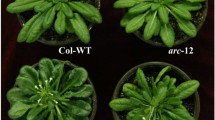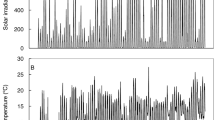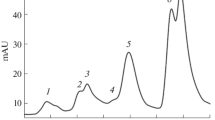Abstract
Photosynthetic activities of a chilling-sensitive species, Nicotiana tabacum L. (cv. Samsun), and a chilling-resistant plant, Arabidopsis thaliana Heynh. (L) (ecotype Columbia), were examined in young seedlings exposed to low temperatures. Functional parameters were determined after 1- to 6-day exposure of tobacco and arabidopsis plants at 8 and 2°C, respectively. In tobacco leaves sampled by the end of the experiment, the chlorophyll content decreased by 30%, the ratio of variable to maximum Chl a fluorescence (Fv/Fm) decreased by 5%, and the rate of net (apparent) photosynthesis diminished almost twofold. The concentration of soluble sugars in tobacco leaves increased by 30% approaching 130 mg/g dry wt. In arabidopsis, unlike tobacco, the content and proportions of photosynthetic pigments, as well as the Fv/Fm ratio changed insignificantly upon cooling, whereas net photosynthetic rates decreased to a lesser extent (by a factor of 1.6). The content of sugars in arabidopsis leaves increased fourfold by the end of the low-temperature treatment and reached 90 mg/g dry wt. Thus, the photosynthetic apparatus in chill-sensitive and cold-resistant plants responded differently to chilling temperatures. The data provide evidence that the photosynthetic apparatus in arabidopsis is well preserved upon chilling and can function effectively at cold-hardening temperatures. The thylakoid processes and the reactions of photosynthetic carbon metabolism in leaves of heat-loving tobacco plants are more sensitive to chilling temperatures and undergo changes in a more or less coordinated manner, helping chloroplasts to avoid the excessive generation of reactive oxygen species.





Similar content being viewed by others
REFERENCES
Theocharis, A., Clement, C., and Barka, E.A., Physiological and molecular changes in plants grown at low temperatures, Planta, 2012, vol. 235, pp. 1091–1105.
Trunova, T.I., Rastenie i nizkotemperaturnyi stress. 64‑e Timiryazevskoe chtenie (Plant and Low Temperature Stress, the 64th Timiryazev Lecture), Moscow: Nauka, 2007.
Fortunato, A.S., Lidon, F.C., Batista-Santos, P., Leitao, A.E., Pais, I.P., Ribeiro, A.I., and Ramalho, J.C., Biochemical and molecular characterization of the antioxidative system of Coffea sp. under cold conditions in genotypes with contrasting tolerance, J. Plant Physiol., 2010, vol. 160, pp. 333–342.
Hasdai, M., Weiss, B., Levi, A., Samach, A., and Porat, R., Differential responses of Arabidopsis ecotypes to cold, chilling and freezing temperatures, Ann. Appl. Biol., 2006, vol. 148, pp. 113–120.
Markovskaya, E.F., Sysoeva, M.I., and Sherudilo, E.G., The effect of daily exposure to low hardening temperature on plant vital activity, Russ. J. Dev. Biol., 2008, vol. 39, pp. 261–268.
Klimov, S.V., Popov, V.N., Dubinina, I.M., Burakhanova, E.A., and Trunova, T.I., The decreased cold-resistance of chilling-sensitive plants is related to suppressed CO2 assimilation in leaves and sugar accumulation in roots, Russ. J. Plant Physiol., 2002, vol. 49, pp. 776–781.
Klimov, S.V., Dubinina, I.M., Burakhanova, E.A., Astakhova, N.V., Popov, V.N., Alieva, G.P., and Trunova, T.I., CO2 exchange as related to sugar accumulation and invertase activity during winter wheat cold hardening, Dokl. Biol. Sci., 2004, vol. 398, pp. 379–381.
Lichtenthaler, H.K., Chlorophylls and carotenoids—pigments of photosynthetic biomembranes, Methods Enzymol., 1987, vol. 148, pp. 350–382.
Klimov, S.V., Cold hardening of plants is a result of maintenance of an increased photosynthesis/respiration ratio at low temperature, Biol. Bull. Russ. Acad. Sci., 2003, vol. 30, pp. 48–52.
Rakhmankulova, Z.F., Shuiskaya, E.V., Suyundu-kov, Ya.T., Usmanov, I.Yu., and Voronin, P.Yu., Different responses of two ecotypes of C3–C4 xero-halophyte Bassia sedoides to osmotic and ionic factors of salt stress, Russ. J. Plant Physiol., 2016, vol. 63, pp. 229–237.
Turkina, M.V. and Sokolova, S.V., Methods for the determination of monosaccharides and oligosaccharides, in Biokhimicheskie metody v fiziologii rastenii (Biochemical Methods in Plant Physiology), Pavlinova, O.A., Ed., Moscow: Nauka, 1971, pp. 7–34.
Dospekhov, B.A., Metodika opytnogo dela (Methods for Experimental Work), Moscow: Kolos, 1977.
Klimov, S.V., Trunova, T.I., and Mokronosov, A.T., Mechanism of plant adaptation to unfavorable environmental conditions through modification of source–sink relations, Sov. Plant Physiol., 1990, vol. 37, pp. 1024–1035.
Lichtenthaler, H.K., Ac, A., Marek, M.V., Kalina, J., and Urban, O., Differences in pigment composition, photosynthetic rates and chlorophyll fluorescence images of sun and shade leaves of four tree species, Plant Physiol. Biochem., 2007, vol. 45, pp. 577–588.
Lepeduš, H., Vuletić, M.V., Cesar, V., and Ljubešić, N., Functioning of the photosynthetic apparatus under low and high light conditions in chlorotic spruce needles as evaluated by in vivo chlorophyll fluorescence, Russ. J. Plant Physiol., 2005, vol. 52, pp. 165–170.
Siefferman-Harms, D., The light-harvesting and protecting functions of carotenoids in photosynthetic membranes, Physiol. Plant., 1987, vol. 69, pp. 561–568.
Demming-Adams, B. and Adams, W.W., Photoprotection and other responses of plants to high light stress, Annu. Rev. Plant Physiol. Plant Mol. Biol., 1992, vol. 43, pp. 599–626.
Sarieva, G.E., Kenzhebaeva, S.S., and Lichtentha-ler, H.K., Adaptation potential of photosynthesis in wheat cultivars with a capability of leaf rolling under high temperature conditions, Russ. J. Plant Physiol., 2010, vol. 57, pp. 28–36.
Du, Y.C., Nose, A., and Wasano, K., Effects of chilling temperature on photosynthetic rates, photosynthetic enzyme activities and metabolite levels in leaves of three sugarcane species, Plant Cell Environ., 1999, vol. 22, pp. 317–324.
Sowinski, P., Rudzinska-Langwald, A., and Kobus, P., Changes in plasmodesmata frequency in vascular bundles of maize seedling leaf induced by growth at sub-optimal temperatures in relation to photosynthesis and assimilate export, Environ. Exp. Bot., 2003, vol. 50, pp. 183–196.
Klimov, S.V., Bioenergetic aspects of adaptation and resistance of wintering cereals to frost, Usp. Sovrem. Biol., 1987, vol. 104, pp. 251–267.
Krall, J.P. and Edwards, G.E., Relationship between photosystem II activity and CO2 fixation in leaves, Physiol. Plant., 1992, vol. 86, pp. 180–187.
Baker, N.R., Chlorophyll fluorescence: a probe of photosynthesis in vivo, Annu. Rev. Plant Biol., 2008, vol. 59, pp. 89–113.
Winter, H. and Huber, S.C., Regulation of sucrose metabolism in higher plants: localization and regulation of activity of key enzymes, Crit. Rev. Plant Sci., 2000, vol. 19, pp. 31–67.
Astakhova, N.V., Popov, V.N., Selivanov, A.A., Burakhanova, E.A., Alieva, G.P., and Moshkov, I.E., Reorganization of chloroplast ultrastructure associated with low-temperature hardening of Arabidopsis plants, Russ. J. Plant Physiol., 2014, vol. 61, pp. 744–750.
Popov, V.N., Antipina, O.V., and Trunova, T.I., Lipid peroxidation during low-temperature adaptation of cold-sensitive tobacco leaves and roots, Russ. J. Plant Physiol., 2010, vol. 57, pp. 144–147.
Foyer, C.H., Vanacker, H., Gomez, L.D., and Harbinson, J., Regulation of photosynthesis and antioxidant metabolism in maize leaves at optimal and chilling temperatures: review, Plant Physiol. Biochem., 2002, vol. 40, pp. 659–668.
Foyer, C.H. and Noctor, G., Redox regulation in photosynthetic organisms: signaling, acclimation and practical implications, Antioxid. Redox Signal., 2009, vol. 11, pp. 861–905.
Popov, V.N., Antipina, O.V., and Astakhova, N.V., Changes in chloroplast ultrastructure of tobacco plants in the course of protection from oxidative stress under hypothermia, Russ. J. Plant Physiol., 2016, vol. 63, pp. 181–187.
Sin’kevich, M.S., Selivanov, A.A., Antipina, O.V., Kropocheva, E.V., Alieva, G.P., Suvorova, T.A., Astakhova, N.V., and Moshkov, I.E., Activities of antioxidant enzymes of Arabidopsis thaliana plants during cold hardening to hypothermia, Russ. J. Plant Physiol., 2016, vol. 63, pp. 750–754.
COMPLIANCE WITH ETHICAL STANDARDS
The authors declare that they have no conflict of interest. This article does not contain any studies involving animals or human participants performed by any of the authors.
Author information
Authors and Affiliations
Corresponding author
Additional information
Translated by A. Bulychev
Abbreviations: Car—carotenoids; Chl—chlorophyll; ETC—electron transport chain; Fv/Fm—ratio of variable to maximum Chl a fluorescence in photosystem II; PFD—photon flux density; PSII—photosystem II; ROS—reactive oxygen species.
Rights and permissions
About this article
Cite this article
Popov, V.N., Antipina, O.V., Selivanov, A.A. et al. Functional Activity of the Photosynthetic Apparatus in Tobacco and Arabidopsis Plants Exposed to Chilling Temperatures. Russ J Plant Physiol 66, 102–109 (2019). https://doi.org/10.1134/S1021443719010138
Received:
Revised:
Accepted:
Published:
Issue Date:
DOI: https://doi.org/10.1134/S1021443719010138




